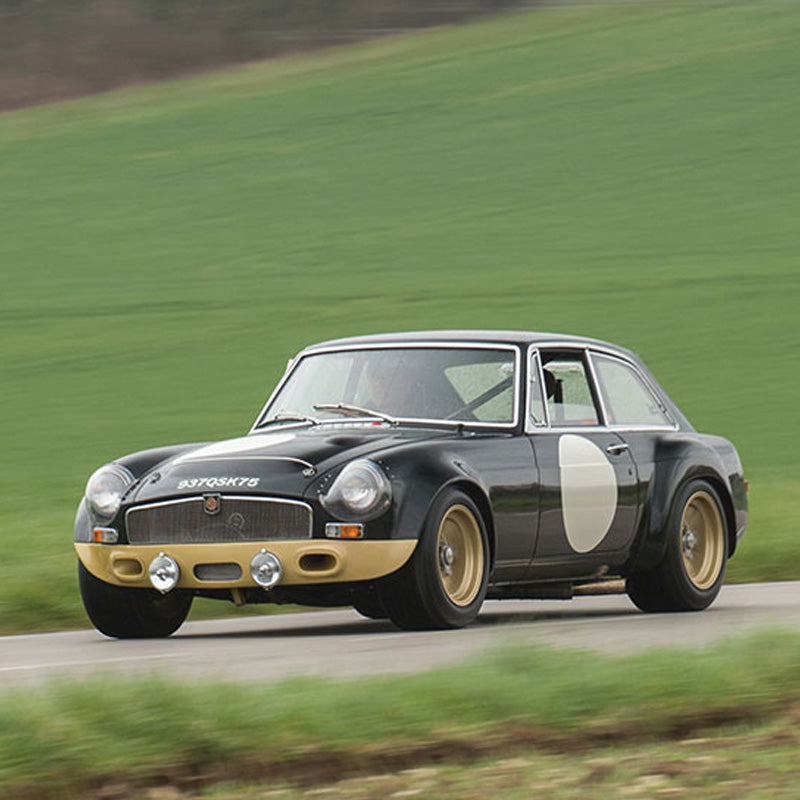Photography courtesy of RM Sotheby's
The MGB and MGC series are some of the most common classic sports cars. You don’t even have to be into cars and you’ll likely know what an MG is, and probably that it’s British. It’s hard to dislike their simple, near timeless design—hell, even my mother, who’s no petrolhead, lovingly owned two of them in the 1980s.
With classic sportscar proportions, lightweight construction, and a capable chassis, it’s easy to see why they were, and still are, so popular amongst enthusiasts. In a sense, they’re the Volkswagen Beetle of the sports car realm: cheap, easy to work on, and they made a ton of them—more than a half million, in fact.



If you’re an MG fanatic, you’ll likely recognize the very special black and gold specimen photographed here. But if you’re like me, at first glance you probably think this is some do-it-yourselfer’s garage built one-off racecar, but you’d be wrong. Turns out, this is one of six GTS Sebring models by The British Motor Corporation (BMC) Competition Department…well, sort of.
In 1966, the BMC race house in Abingdon began a new program in hopes to boost sales for the not-yet-released MGC. Starting off with six MGB/MGC hybrid chassis, the development team began by constructing just two prototypes. Knowing its tuned straight six engines weren’t mighty enough to outrun the competition, the team took a different approach for speed: by shedding as much weight as possible.
While the chassis remained steel, the doors, roof skin, bonnet, boot lid, and blister arched fenders and quarters were crafted from aluminum. The headlamps received plastic aero-covers, widened spoke wheels wrapped in sticky tread were tucked snuggly under the widened panels, and the unnecessary bumpers were removed—we love bumper-less classics.



The two “GTS” prototypes went on to race in the Targa Florio, Marathon de la Route at Nürburgring, and Sebring before the program was cancelled in 1970—but whatever happened to the remaining four BMC chassis? Remember, only two of the six hybrid chassis were completed by BMC. Well, this 1969 MG MGC GTS Sebring is one of those remaining four cars.
Upon dissolution of the BMC “GTS” competition program, Austin-Healey specialist John Chatham was offered the unfinished surplus, which he thankfully purchased. John completed chassis MGC 500757 for competition using the latest goodies in the BMC parts bin—making this car an even better performer than the two BMC GTS racers. Stronger magnesium Minilite rollers were selected over the standard brittle wire wheels—but the originals are included in the sale. What makes this already very special MG even more unique is what lies under the alloy bonnet.
During the BMC GTS racing program, straight six aluminum block powertrains were tested but never installed in either of the two racing prototypes—this Sebring is believed to have the only remaining aluminum block left in existence. With triple Webers feeding the established 220 horsepower on tap, this bespoke “super lightweight” GTS Sebring weighs just ~900 kilos (less than one ton)!
John Chatham extensively raced this custom super-MG at Silverstone, Castle Combe, and more, until selling the car to its current owner in 2004. The car has since been restored and is now ready for another half century of competition.
It’s odd to see such a common-looking car in such an elevated light, but if superhero movies have taught me anything, it’s that exceptional things are often hiding in plain sight.

History
– One of six genuine GTS Sebring chassis
– Driven by racing legend John Chatham
Specifications
Est. 220 hp, 2,912 cc OHV inline six-cylinder engine with triple Weber carburetors, four-speed manual transmission with overdrive, independent front suspension, live rear axle with semi-elliptical leaf springs, and four-wheel hydraulic disc brakes. Wheelbase: 2,311 mm.
Vehicle information
Chassis no.: MGC 500757
Engine no.: AXSP JC 101
Body no.: GCD1 03307
Valuation
– Complete with FIA paperwork
Auction house: RM Sotheby's
Estimate: TBD
Price realized: Auction on May 14























































